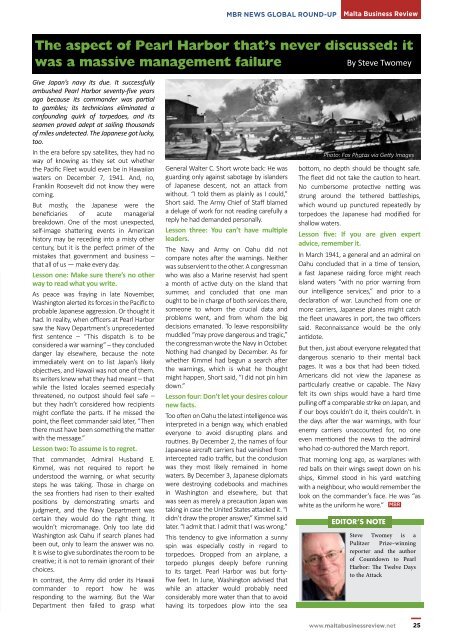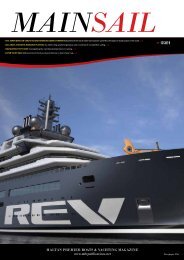You also want an ePaper? Increase the reach of your titles
YUMPU automatically turns print PDFs into web optimized ePapers that Google loves.
<strong>MBR</strong> News Global Round-Up<br />
Malta Business Review<br />
The aspect of Pearl Harbor that’s never discussed: it<br />
was a massive management failure<br />
By Steve Twomey<br />
Give Japan’s navy its due. It successfully<br />
ambushed Pearl Harbor seventy-five years<br />
ago because its commander was partial<br />
to gambles; its technicians eliminated a<br />
confounding quirk of torpedoes, and its<br />
seamen proved adept at sailing thousands<br />
of miles undetected. The Japanese got lucky,<br />
too.<br />
In the era before spy satellites, they had no<br />
way of knowing as they set out whether<br />
the Pacific Fleet would even be in Hawaiian<br />
waters on December 7, 1941. And, no,<br />
Franklin Roosevelt did not know they were<br />
coming.<br />
But mostly, the Japanese were the<br />
beneficiaries of acute managerial<br />
breakdown. One of the most unexpected,<br />
self-image shattering events in American<br />
history may be receding into a misty other<br />
century, but it is the perfect primer of the<br />
mistakes that government and business –<br />
that <strong>all</strong> of us — make every day.<br />
Lesson one: Make sure there’s no other<br />
way to read what you write.<br />
As peace was fraying in late November,<br />
Washington alerted its forces in the Pacific to<br />
probable Japanese agg<strong>res</strong>sion. Or thought it<br />
had. In reality, when officers at Pearl Harbor<br />
saw the Navy Department’s unprecedented<br />
first sentence – “This dispatch is to be<br />
considered a war warning” – they concluded<br />
danger lay elsewhere, because the note<br />
immediately went on to list Japan’s likely<br />
objectives, and Hawaii was not one of them.<br />
Its writers knew what they had meant – that<br />
while the listed locales seemed especi<strong>all</strong>y<br />
threatened, no outpost should feel safe –<br />
but they hadn’t considered how recipients<br />
might conflate the parts. If he missed the<br />
point, the fleet commander said later, “Then<br />
there must have been something the matter<br />
with the message.”<br />
Lesson two: To assume is to regret.<br />
That commander, Admiral Husband E.<br />
Kimmel, was not required to report he<br />
understood the warning, or what security<br />
steps he was taking. Those in charge on<br />
the sea frontiers had risen to their exalted<br />
positions by demonstrating smarts and<br />
judgment, and the Navy Department was<br />
certain they would do the right thing. It<br />
wouldn’t micromanage. Only too late did<br />
Washington ask Oahu if search planes had<br />
been out, only to learn the answer was no.<br />
It is wise to give subordinates the room to be<br />
creative; it is not to remain ignorant of their<br />
choices.<br />
In contrast, the Army did order its Hawaii<br />
commander to report how he was<br />
<strong>res</strong>ponding to the warning. But the War<br />
Department then failed to grasp what<br />
General Walter C. Short wrote back: He was<br />
guarding only against sabotage by islanders<br />
of Japanese descent, not an attack from<br />
without. “I told them as plainly as I could,”<br />
Short said. The Army Chief of Staff blamed<br />
a deluge of work for not reading carefully a<br />
reply he had demanded person<strong>all</strong>y.<br />
Lesson three: You can’t have multiple<br />
leaders.<br />
The Navy and Army on Oahu did not<br />
compare notes after the warnings. Neither<br />
was subservient to the other. A cong<strong>res</strong>sman<br />
who was also a Marine <strong>res</strong>ervist had spent<br />
a month of active duty on the island that<br />
summer, and concluded that one man<br />
ought to be in charge of both services there,<br />
someone to whom the crucial data and<br />
problems went, and from whom the big<br />
decisions emanated. To leave <strong>res</strong>ponsibility<br />
muddled “may prove dangerous and tragic,”<br />
the cong<strong>res</strong>sman wrote the Navy in October.<br />
Nothing had changed by December. As for<br />
whether Kimmel had begun a search after<br />
the warnings, which is what he thought<br />
might happen, Short said, “I did not pin him<br />
down.”<br />
Lesson four: Don’t let your desi<strong>res</strong> colour<br />
new facts.<br />
Too often on Oahu the latest intelligence was<br />
interpreted in a benign way, which enabled<br />
everyone to avoid disrupting plans and<br />
routines. By December 2, the names of four<br />
Japanese aircraft carriers had vanished from<br />
intercepted radio traffic, but the conclusion<br />
was they most likely remained in home<br />
waters. By December 3, Japanese diplomats<br />
were destroying codebooks and machines<br />
in Washington and elsewhere, but that<br />
was seen as merely a precaution Japan was<br />
taking in case the United States attacked it. “I<br />
didn’t draw the proper answer,” Kimmel said<br />
later. “I admit that. I admit that I was wrong.”<br />
This tendency to give information a sunny<br />
spin was especi<strong>all</strong>y costly in regard to<br />
torpedoes. Dropped from an airplane, a<br />
torpedo plunges deeply before running<br />
to its target. Pearl Harbor was but fortyfive<br />
feet. In June, Washington advised that<br />
while an attacker would probably need<br />
considerably more water than that to avoid<br />
having its torpedoes p<strong>low</strong> into the sea<br />
Photo: Fox Photos via Getty Images<br />
bottom, no depth should be thought safe.<br />
The fleet did not take the caution to heart.<br />
No cumbersome protective netting was<br />
strung around the tethered battleships,<br />
which wound up punctured repeatedly by<br />
torpedoes the Japanese had modified for<br />
shal<strong>low</strong> waters.<br />
Lesson five: If you are given expert<br />
advice, remember it.<br />
In March 1941, a general and an admiral on<br />
Oahu concluded that in a time of tension,<br />
a fast Japanese raiding force might reach<br />
island waters “with no prior warning from<br />
our intelligence services,” and prior to a<br />
declaration of war. Launched from one or<br />
more carriers, Japanese planes might catch<br />
the fleet unawa<strong>res</strong> in port, the two officers<br />
said. Reconnaissance would be the only<br />
antidote.<br />
But then, just about everyone relegated that<br />
dangerous scenario to their mental back<br />
pages. It was a box that had been ticked.<br />
Americans did not view the Japanese as<br />
particularly creative or capable. The Navy<br />
felt its own ships would have a hard time<br />
pulling off a comparable strike on Japan, and<br />
if our boys couldn’t do it, theirs couldn’t. In<br />
the days after the war warnings, with four<br />
enemy carriers unaccounted for, no one<br />
even mentioned the news to the admiral<br />
who had co-authored the March report.<br />
That morning long ago, as warplanes with<br />
red b<strong>all</strong>s on their wings swept down on his<br />
ships, Kimmel stood in his yard watching<br />
with a neighbour, who would remember the<br />
look on the commander’s face. He was “as<br />
white as the uniform he wore.” <strong>MBR</strong><br />
EDITOR’S NOTE<br />
Steve Twomey is a<br />
Pulitzer Prize–winning<br />
reporter and the author<br />
of Countdown to Pearl<br />
Harbor: The Twelve Days<br />
to the Attack<br />
www.maltabusinessreview.net<br />
<strong>25</strong>

















